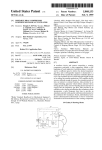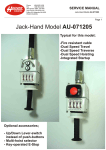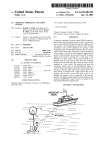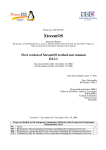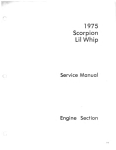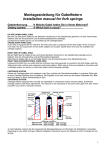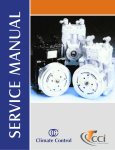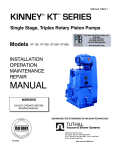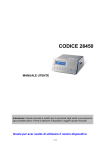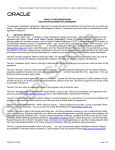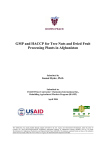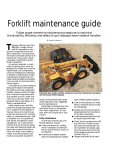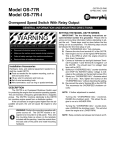Download [j_0|L FILLED
Transcript
United States Patent [19] [11] 4,419,056 Ege [45] Dec. 6, 1983 [54] BACK-UP FOR HIGH VOLTAGE CABLE PRESSURIZING SYSTEM [75] Inventor: Sigmund Ege, Oslo, Norway [73] Assignee: International Standard Electric 2,817,396 12/1957 Booth ................................ .. 417/428 3,388,207 6/1968 Lansch .. 137/567 3,782,863 1/1974 Rupp ...... .. 417/393 4,080,107 3/1978 Ferrentino 417/273 4,341,508 7/1982 Rambin, Jr. ....................... .. 417/426 Primary Examiner—Carlton R. Croyle Corporation, New York, NY. [21] Appl. No: 285,700 Assistant Examiner—Paul F. Neils Attorney, Agent, or Firm-John T. O’Halloran; Alfred [22] Filed: C. Hill [30] Jul. 22, 1981 Aug. 4, 1980 [NO] [51] [52] [57] Foreign Application Priority Data Norway ............................... ., 802327 Int. Cl.3 ...................... .. F04B 23/04; F04B 43/06 U.S. Cl. .................................... .. 417/426; 417/53; 417/393; 92/5 R [58] Field of Search ............... .. 417/63, 374, 425, 426, 417/434, 435, 53, 393, 395; 92/5 R; 91/1, 51; 60/571 [56] References Cited ABSTRACT A back-up system is provided for a pumping plant or a pressure reservoir system used to maintain insulating oil under pressure in high voltage submarine power cables which includes a gas driven membrane pump to insure a small outflow of oil at a rupture point in the power cable to prevent water from penetrating the cable. The proper operation of the membrane pump is insured by introducing degasi?ed oil at the drive side of the pump during the stand-by and test modes of operation of the back-up system. U.S. PATENT DOCUMENTS 1,627,257 5/1927 Stevens ............................... .. 417/63 /O|LOUTLET CHAMBER 5f DIAPHRAGM/J PUMP 5b [j_0|L FILLED z, POWER CABLE / c 20 Claims, 19 Drawing Figures US. Patent Dec. 6, 1983 1, $10K FILLED POWER CABLE Sheet 1 of5 4,419,056 U.S. Patent Dec. 6, 1983 2E Sheet 2 of5 “i i; ll _2_27 4,419,056 27 22. U.S. Patent Dec. 6, 1983 Sheet 3 of5 Fig .17. 4,419,056 U.S. Patent Dec. 6, 1983 Sheet4 of5 4,419,056 U.S. Patent Dec. 6, 1983 Sheet 5 of5 4,419,056 1 4,419,056 BACK-UP FOR HIGH VOLTAGE CABLE PRESSURIZING SYSTEM BACKGROUND OF THE INVENTION Paper and oil insulated high voltage power cables rely on maintaining the insulating oil under pressure for the proper functioning. In the case of the so-called Pipe Type ‘Cable (three insulated conductors pulled into a common steel pipe) the pressure is normally maintained‘ by a pump drawing oil from an oil tank. The so-called Self Contained Cable is normally kept under pressure by means of static oil reservoirs, although in certain cases a “Pumping Plant” may also be used for this type 2 moisture to permeate through the membrane to the cable oil on the other side. SUMMARY OF THE INVENTION The main object of the present invention is to over come the disadvantage of the previously known back up systems. The present invention overcomes the disadvantages of known back-up systems by comprising at least one diaphragm pump for pumping cable oil from an oil reservoir to the cable core in case of rupture of the cable sheath causing oil leaks and means for providing that the drive or gas side and the inlet/outlet or suction side of the diaphragm of the pump are subjected to oil at of cable, particularly in the case of long submarine 15 least during the stand-by mode of the pump. By ?lling the gas side of the membranes with degasi crossings. ?ed cable oil, this part of the pump may be maintained One reason why pumping plants are being used also under a positive pressure (by means of the same type of for Self Contained Submarine Cables is that with this pressure reservoir which is used on the cable, or—in the system it is reasonably inexpensive to store a large quan tity of oil in case the cable should become ruptured, so case of a system with pumping plant—from the electric that one might prevent water from entering the cable by pump which maintains pressure on the cable) until the creating a certain small out?ow of oil at the rupture pump is called upon to provide additional oil to the point. The pumping plant is, however, dependent on cable (for instance due to a leak developing) or—in the supply of electricity. The oil reservoir system does not case of a system with pumping plant—to take over from require electricity, but the cost of providing extra oil 25 the electric pump in case of power failure. At this time capacity for a possible cable rupture becomes prohibi the oil on the drive side of the membrane will, of course, tive. be replaced by the driving gas, but this condition will For pumping plants, pumps relying on means other only persist until such a time as the leak in the cable has than electric motors are known to have been used as a been stopped (or the cable end capped in case of a com back-up in case of power failure. The back-up pump 30 plete severance) and the cable again can be kept under may have been driven by an air motor, fed either with pressure by the reservoirs. This time period will be air or nitrogen stored under high pressure in gas cylin fairly short, and moisture and gas will not have time to ders. permeate the membrane to any detrimental degree. If a suitable system could be developed which could In preparing the pump for “stand-by,” vacuum can be 35 act as a back-up for a pumping plant, such a system pulled on the whole pump (both on the oil side and the ought to be suitable also as a back-up for pressure reser gas side of the membranes, including the valve system voirs in case a leak should develop in the cable system. Unfortunately the oil in a Self Contained Cable must be virtually completely free from moisture and gas in which makes the rod connecting the two membranes reciprocate). While the pump is still under vacuum it is order to function properly as an insulation together 40 ?lled with degasi?ed oil. One added advantage of the invention is that all the with the paper. For this reason it is, for instance, not critical parts (in particular the valve system) will be permissible to store such oil under a “blanket” of nitro kept in good condition by the oil, so that one may be gen, such as is normally the case for a pipe-type cable certain that the pump really will work after having been pumping plant. For this reason it is known to use so called “canned” motors to drive the pump in pumping 45 standing idle, maybe for years. When the back-up system has performed its function, plants for this type of cable. Use of these hermetic mo the pump can again be evacuated and ?lled with degasi tors excludes the need for a rotating seal on the shaft ?ed oil. This could conveniently be done at the time between the motor and the pump. Such a shaftseal is that the oil storage tank is being evacuated to be re?lled particularly undesirable in the case of a pump which is with degasi?ed oil. to stand as a back-up, maybe for several years, before it According to one embodiment of the invention, is called upon to pump oil. which is particularly convenient when the invention is Hermetic motor-pump combinations for air driven used in connection with a standard pumping plant, it is motors without a rotating seal do not exist. The pumps possible to make a periodic check on the functioning of which come closest to being “hermetic” are those using the diaphragm or membrane principle. One such pump 55 the “gas-driven” pump without introducing gas into the gas chamber of the pump. This is accomplished by (marketed by THE WARREN RUPP CO. Mans?eld, driving the pump by means of oil under pressure sup Ohio under the trade name “Sand Piper” Pump Model No. SAI-A or SBl-A) utilizing two membranes con nected by a rod and with a driving gas in contact with the “rod-side” of the two membranes, seems particu larly well suited for the purpose. A diaphragm or mem plied by the electric oil pump which normally applies pressure to the cable system. Such a test will ?rst of all prove that the pump really will operate should it be asked to take over the pumping action, and the oil which during stand-by has been sitting in the “oil cham brane pump of this type is shown in Operating Instruc ber” of the pump during this time, could be checked for tions, Service Manual and Repair Parts List, issued as gas content and power factor. With oil on both sides of Form No. SPL-2/77R by The Warren Rupp Co. and fully disclosed in US. Pat. No. 3,782,863, whose disclo 65 the membrane it will also be possible to make sensitive tests for possible cracks in the membrane by valving off sure is incorporated herein by reference. The only dis the two sides of the membrane and monitoring the dif advantage is that it utilizes a membrane which is not ferential pressure. made of metal, and therefore, in time, will allow gas and 3 4,419,056 The above test could also be made on the back-up system for cables supplied with pressure oil reservoirs, but in this case a separate degasi?er and an oil pump will have to be used to perform the test. According to one embodiment of the invention the back-up system is mounted on a skid containing all the required units such as storage tank, pressure reservoir, pump and gas bottles. Such a back-up may be evacuated and ?lled with treated oil at the factory, shipped to site 4 FIGS. 17-19 show three modes of operation of the arrangement of FIG. 16. DETAILED DESCRIPTION OF THE INVENTION In FIG. 1 only three elements of a standard pumping plant have been included, namely, an oil storage tank 1, an electrical pump 2 and a check valve 3 which pre pump with a metallic membrane is being used, particu vents oil from returning to the tank when the pump is not running. The oil ducts of the oil ?lled cables are connected to the pumping plant at 4. In FIG. 2 is given the legend of the valves shown in FIG. 1 (and also in FIG. 6). A illustrates a manually larly if one should require that the pump should be operated valve, B illustrates an electrically operated started up occasionally in order to make sure that it really will pump effectively if called upon to do so. If the “gas side” of the membrane, it may have serious consequences to the cable if a crack should develop in the membrane, since the gas immediately will enter the valve, and C illustrates a so~called check valve allowing fluid ?ow in the direction of the arrow only. Turning now back to FIG. 1, the standard pumping plant has been provided with a back-up system consist ing mainly of a membrane pump 5, like that described above under the heading “Background of the Inven cable. With the present invention the danger is elimi tion” marketed by The Warren Rupp Company under and hooked up to the existing pressurizing system either of the reservoir or the pumping plant type. The inven tion may be used to advantage even in the case where a such a test were to be made with gas rather than oil on nated since we have degasi?ed oil on both sides of the the trade name “Sand Piper” Pump Model No. SAl-A membrane. It is true that gas could still come through a or SBl-A utilizing two membranes 5a and 512 connected broken membrane if the back-up system should ever be by a rod 5c and having a driving gas in contact with the called upon to maintain pressure on the cable, but at this 25 “rod-side” of the two membranes 5:: and 5b in a ?rst time the power will have been shut off the cable, and chamber 5d, a suction input a terminating in a second oil the introduction of dry nitrogen is therefore not so inlet chamber 50 and an oil outlet terminating in a third serious. The gas will not cause an electric breakdown of or oil outlet chamber 5}‘. The driving gas is provided by the cable and may be removed by subsequent treatment a battery of gas bottles 6 via a pressure reducing valve of the cable oil prior to reenergizing the cable. 7. The inlet and outlet of the “rod-side” or "gas side” of An alternative solution to the problem outlined above the pump are indicated by b and d, respectively, while is to introduce an additional diaphragm type pump, so a represents the oil suction side and c the oil outlet. The that the drive side of the main pump is always operated by degasi?ed oil supplied from the additional pump. The additional pump may be operated during its test and operation mode by pressurized gas or air. While the possibility exists with the additional pump that its dia phragm may rupture and gas or air may be introduced back-up system also includes three electrically operated valves 8, 9 and 10 (these valves are operated by DC current from a stand-by battery), one manually operated valve 11 (apart from those connected directly to the gas bottles 6), and two check valves 12, 13. The pumping/back-up system has three modes of into the oil system on its pump side, the risk of transfer ring deteriorated oil into the pump side of the main pump is negligible, because the oil on the pump side of the additional pump and on the drive side of the main operation mode. In order to give a clear understanding of the various modes of operation, the state of the valves is given in the table below where O=open valve, pump is frequently degasi?ed. C=closed valve. BRIEF DESCRIPTION OF THE DRAWINGS To give a better understanding of the invention, two examples of its application will be given below, with reference to the accompanying drawings, in which FIG. 1 shows the invention used in conjunction with a pumping plant, FIG. 2 shows a legend of valves, FIGS. 3-5 schematically illustrate three modes of operation of the arrangement of FIG. 1, FIG. 6 shows how a back-up may be provided for a cable installation using pressure reservoirs to maintain operation: a stand-by mode, a test mode and a back-up ' Mode/Valve No. Stand-by Test Operation 0w0 0\0 050 CO In the stand-by mode which is also schematically illustrated in FIG. 3, the membrane pump 5 is kept full of oil on both sides of the membrane. On the suction side a the oil is maintained at a pressure equivalent to the head of oil in the storage tank (this tank being kept pressure on the cable, under vacuum), while the oil on the “gas side” of the FIGS. 7-10 schematically illustrate four modes of operation of the arrangement of FIG. 6, provided by the electrical pump 2 for the cable at 4. pump will be maintained under the same pressure as that FIG. 11 shows how the back-up system may be In order to test that the membrane pump 5 is opera mounted on a skid for pre-fabrication and transporta ble, without introducing gas into the pump, all valves but valve 9 are opened. (Valve 11 opened slightly only). Oil will now ?ow from the tank 1, via the electrical tion to site, FIG. 12 schematically illustrates a back-up system for pump 2 and valve 10 to operate the membrane pump 5 a pumping plant, employing two diaphragm pumps, because the outlet (1 is opened by the open valve 8. As FIGS. 13-15 show the three modes of operation of 65 a result the pump 5 will pump oil from its a side to its c the arrangement of FIG. 12, side, the pumped oil being drained through valve 11. FIG. 16 schematically illustrates the two diaphragm pump solution in connection with pressure reservoir The drained oil from valve 11 as well as oil exhausted plant, and through valve 8 should be tested for deteriorations to 4,419,056 5 6 obtain indication of the condition of the back-up system. The drained oil should, if necessary, be degasi?ed and portable source of degasi?ed oil 27 will have to be brought in and connected to valve 26. The test may be pumped back to the tank 1. The test mode is also illus performed by opening valves 26 and 8 (after ?rst having closed valves 21 and 25) sothat the supply of degasi?ed trated in; FIG. 4. ' I _ i If the electric power should fail so that the electrical pump 2 is unable to maintain therequired pressure in the cable at 4, valve 10 will be switched from open to closed and thereafter valves 8 and 9 vfromfclosed to open. In thismode, which is illustrated in FIG._5, the gas ‘which is supplied from the gas bottle battery 6_, will ?rst force the stand-by oil ,within the pump 5 out through valve 8 while operating the pump 5, and ?nally oil operates the pump. Oil from the tank 22 is exhausted through valve 11.as in the case of FIG. 1, and the oil on thea/c-side of the pump 5 can be tested for deteriora tions. Also the oil drained at pump outlet d should be checked for deteriorations. . -' - .If the cable should start leaking oil as a result of eXter nal mechanical damage, or for other reasons, the pres sure reservoirs 20 will feed additional oil to the cable at operate the pump '5 on gas as intended. By operation of 4, whereby the pressure will gradually decrease. When the pump 5, oil will be supplied from the tank 1 to the the pressure approaches a critical low limit, as sensed by cable at 4. ' 15 a pressure switch (not shown), valve 25 will be closed When‘ reinstating the stand-by mode after repair of a ?rst, and valves 8 and 9 will open. This will initiate fault which caused the back-up pump to operate, the operation of the membrane pump, and valve 21 is ?nally system should ?rst be switched to the test mode. The oil opened to allow the oil to be pumped from the tank 22 tank 1 must not be completely filled‘ with on,‘ since the and into the cable at 4. This is illustrated in FIG. 10. space above the oil is to be maintainedunder vacuum Since vacuum will be created above the oil in the tank provided by a continuously running vacuum pump (not 22 as soon as the pump 5 starts pumping, the gas driven shown). ’ In FIG. 6 is illustrated a different embodiment of the invention used in connection with a standard pressure pump 5 must be located far enough below the tank 22 to give suf?cient head of oil (at least 3-4 feet) to make certain that the pump 5 will prime itself. reservoir systems, where pressure reservoirs 20 provide 25 According to one embodiment of the invention the oil for the cable at 4. The elements 5-9, 11, and 12, suction line is hinged just below the tank, so that the which are the main parts of the back-up system, are the lower portion of this line, with the pump S,'may be same as in FIG. 1. A valve 21 is introduced between the rotated 90° (in the middle of the skid) to reduce the back-up system and the pressure reservoir system. The tank 22 is different from the tank 1 shown in 30 space requirement during shipping. In FIG. 11 is schematically illustrated the back-up FIG. ‘1 in that it is maintained completely full of degasi system of FIG. 6 mounted on a skid 30 for pre-fabrica ?ed oil. To compensate for variation in volume of ‘the tion and transportation to site. The membrane pump Sis oil in the tank 22 as the temperature varies, a pressure shown in two positions, the full line position being the reservoir 23 is connected to the tank 22 by means of a installed position in order to obtain the necessary head valve 24. Finally, there is provided a valve 25 for inter connecting the two inputs a and b to the membrane ofoil, while the broken line position illustrates the trans pump during the stand-by mode, and a valve 26 to be portation position. I used in the test mode to ascertain that the membrane In FIG. 12 is schematically illustrated a back-up sys pump 5 operates and when ?lling the tank 22. Oil for tem for a pumping plant. This is an alternative to the initial ?lling of the tank 22 and for testing of the pump system illustrated in FIG. 1, in that the drive or gas side is provided from a source of degasi?ed oil 27. The back (b-d) of the main diaphragm pump 5 is subjected to up system may be assembled in the factory where the pressurized cable oil at all times during the stand-by, tank, pump and pipes are evacuated and ?lled with test and emergency operation modes. This is obtained degasi?ed oil. There are generally four modes of this by‘ letting the pressurized gas or air supplied from the system: an evacuation/?lling mode, a stand-by mode, a 45 tank or bottle 6 operate a second diaphragm pump 14 test mode and a back-up operation mode. The state of identical to the main diaphragm pump 5, i.e. the gas the various valves is given in the table below, and the enters at inlet b and is exhausted through outlet d on the various modes are illustrated in FIGS. 7-10. drive or gas side of this pump 14, thereby obtaining circulation of degasi?ed cable oil from the a-c side of the pump 14 through the b-d side of the main pump 5. 8 Mode/Valve No. 24 Pressure is maintained in this loop by a pressure tank 15 Evacuation C and the oil may occasionally be circulated via a degasi- . Filling ?er (not shown) to degasify the oil and re?ll the tank 15. Stand-by C In comparison with the FIG. 1 layout the valves 8, 10 O Test 0 Operation 55 and 13 have been omitted. The stand-by, test and emer gency operation modes of FIG. 12 layout is schemati cally illustrated in FIGS. 13-15.. In the evacuation and ?lling mode (FIG.7) all valves In FIG. 16 is schematically illustrated an alternative but Nos. 25 and 26 are closed in order to ?rst evacuate back-up system to be used in connection with a pressure the tank 22, pump 5 and associated piping and there reservoir plant described in connection with FIG. 6. As upon ?ll or pump oil into the system. The tank 22 must in the system described above in connection with FIG. be provided with a vacuum pump (not shown) for use 12 there is introduced an additional diaphragm pump 14 prior to and during ?lling. and a pressure reservoir 15 so that degasi?ed oil may be . Once the back-up system is ready for transportation circulated through the two’ diaphragm pumps 5 and '14, to the cable pressure reservoir site, valve 26 should be O0O 000 O20 0 0- 00 0 O0 0 closed and valve 24 opened, whereby the stand-by 65 i.e. from ,the a_-c side of thepump 14 through theb-d side mode of FIG. 8 is obtained. In order to test the membrane pump for proper opera tion on site without introducing gas into the pump 5, a of the pum 15, so that the main pump 5 at all times’ during the stand-by, test and emergency operation modes is ?lled with degasi?ed oil. The circulating oil 4,419,056 7 should occasionally be passed through a degasi?er (not shown). The source of degasi?ed oil 27 needs only to be connected to the system via the manual valves 25' and 26 when required for ?lling purposes. It will be seen that the valve 8 has been omitted. It should be mentioned that the principle of the two series-connected diaphragm pumps may also be used for circulating oil through the degasi?ers. diaphragr- type pump, said second diaphragm type pump supplying said oil to said drive input of In FIGS. 17-19 are schematically illustrated . the stand-by, test and emergency modes of the layout shown in FIG. 15. said one diaphragm-type pump during said stand by, said test and said operating mode of operation. 4. A back-up system according to claim 3, wherein said additional oil supply is a degasi?ed electrical A back-up system of the type outlined in FIG. 16 may of course be installed on a skid 30 as outlined in connec tion with FIG. 11. 8 output coupled to said ?rst chamber of said second diaphragm-type pump, a suction input coupled to an additional supply of said electrical insulating oil and a second chamber of said second diaphragm type pump adjacent‘ one of said two diaphragms and an oil output coupled to a third chamber of said second diaphragm pump adjacent the other of said two diaphragms and to said drive input of ‘said one ‘ ‘ Although the invention has been described in connec insulating oil supply. ' tion with particular embodiments, those skilled in the 5. A back-up system‘according to claim 1, wherein art will perceive modi?cations not mentioned above that can be made without departing from the spirit of the invention. Therefore, the above description is not intended to de?ne the scope of the present invention, 20 said ?rst arrangement includes which is delimited solely by the appended claims. I claim: 1. In a system for pressurizing oil ?lled power cables including an electrical insulating oil source coupled to said power cables to ?ll said power cable with said oil 25 and to maintain oil pressure in said power cable, a back up system to supply said oil to said power cable in case of a rupture of said power cable causing oil leaks com prising: - including an oil pressure tank; and a second valve arrangement coupled between said tank and said reservoir to compensate for pressure variations in said reservoir. 7. A back-up system according to claim 1, further including a second arrangement coupled to said drive input of said one diaphragm-type pump to drive said one diaphragm-type pump by pressurized oil during said test mode of operation. 8. A back-up system according to claim 7, wherein said oil source includes an oil pump coupled to said reservoir, and said second arrangement includes a valve arrangement coupled between said oil pump and said drive input of said one dia phragm-type pump and to said oil output of said 40 power cable is not ruptured, a test mode of opera tion to enable testing of said diaphragm pump and an operate mode of operation when said rupture occurs; and ' during said stand-by mode of operation. 6. A back-up system according to claim 5, further ' a reservoir of said oil; at least one diaphragm-type pump having two spaced diaphragms interconnected by a rod, a gas drive input and a gas drive output coupled to a ?rst chamber disposed between said two diaphragms, a suction input coupled to said oil reservoir and to a 35 second chamber adjacent one of said two dia phragms and an oil output coupled to said power cable and to a third chamber adjacent the other of said two diaphragms, said back-up system having a normal stand-by mode of operation when said 7 a ?rst valve arrangement coupled between said reservoir and said drive input of said one dia phragm-type pump to provide said oil in said ?rst chamber of said one diaphragm-type pump one diaphragm-type pump. 9. A back-up system according to claim 8, wherein said ?rst arrangement includes a portion of said valve arrangement coupled be i a ?rst arrangement coupled tosaid drive input to 45 provide said oil in said ?rst chamber during at least said stand-by mode of operation, said second cham ber being coupled to said oil reservoir during all operating modes such that said second chamber and said ?rst chamber have said oil therein simulta 50 neously during at least said stand-by mode of oper ation. 2. A back-up system according to claim 1, wherein said oil source includes 55 an oil pump coupled to said reservoir, and said ?rst arrangement includes a valve arrangement coupled between said oil pump and said drive input of said one dia phragm-type pump to provide said oil in said ?rst chamber of said one diaphragm-type pump during said stand-by mode of operation. 3. A back-up system according to claim 1, further including a second diaphragm-type pump having two spaced diaphragms interconnected‘ by a rod, a gas drive 65 _ tween said oil pump and said drive input of said one diaphragm-type pump to provide said oil in said ?rst chamber of said one diaphragm-type pump during said stand-by mode of operation. 10. A back-up system according to claim 7, wherein said second arrangement includes ' a degasi?ed oil supply, and a ?rst valve arrangement coupled between said degasi?ed oil supply and said drive input of said one diaphragm-type pump and said oil output of said one diaphragm-type pump. 11. A back-up system according to claim 10, wherein said ?rst arrangement includes ~ . . a second valve arrangement coupled between said reservoir and said drive input of said one dia phragm-type pump to provide said oil in said ?rst chamber of said one diaphragm-type pump during said stand-by mode of operation. 12. A back-up system according to claim 1, further including _ input coupled to a source of driving gas and to a a source of driving gas; and ?rst chamber of said second diaphragm pump dis posed between said two diaphragms, a gas drive a ?rst valve arrangement coupled to at least said ?rst chamber of said one diaphragm-type pump and said 4,419,056 said test mode of operation. 17. A back-up system according to claim 16, wherein said oil source includes an oil pump coupled to said reservoir, and said second arrangement includes a second valve arrangement coupled between said oil pump and said drive input of said one dia phragm-type pump and to said oil output of said one diaphragm-type pump. 18. A back-up system according to claim 17, wherein said ?rst arrangement includes a portion of said second valve arrangement cou pled between said oil pump and said drive input of said one diaphragm-type pump to provide said oil in said ?rst chamber of said one diaphragm type pump during said stand-by mode of opera tion. 19. A back-up system according to claim 16, wherein said second arrangement includes a degasi?ed oil supply, and a second valve arrangement coupled between said 13. A back-up system according to claim 12, wherein said oil source includes an oil pump coupled to said reservoir, and said ?rst arrangement includes a second valve arrangement coupled between said oil pump and said drive input of said one dia phragm-type pump to provide said oil in said ?rst chamber of said one diaphragm-type pump during said stand-by mode of operation. 14. A back-up system according to claim 12, wherein said ?rst arrangement includes a second valve arrangement coupled between said reservoir and said drive input of said one diaphragm-type pump to provide said oil in said ?rst chamber of said one dia phragm-type pump during said stand-by mode of degasi?ed oil supply and said drive input of said operation. one diaphragm-type pump and to said oil output of said one diaphragm-type pump. 15. A back-up system according to claim 14, further including 10 diaphragm-type pump by pressurized oil during source of driving gas to enable said driving gas to operate said one diaphragm-type pump when said rupture occurs and to simultaneously drive said oil from said ?rst chamber of said one diaphragm-type pump. 25 20. A back-up system according to claim 19, wherein said ?rst arrangement includes a third valve arrangement coupled between said an oil pressure tank; and a third valve arrangement coupled between said tank and said reservoir to compensate for pressure vari ations in said reservoir. 16. A back-up system according to claim 12, further reservoir and said drive input of said one dia phragm-type pump to provide said oil in said ?rst chamber of said one diaphragm-type pump including during said stand-by mode of operation. a second arrangement coupled to said drive input of * said one diaphragm-type pump to drive said one 35 45 55 60 65 * * * *











